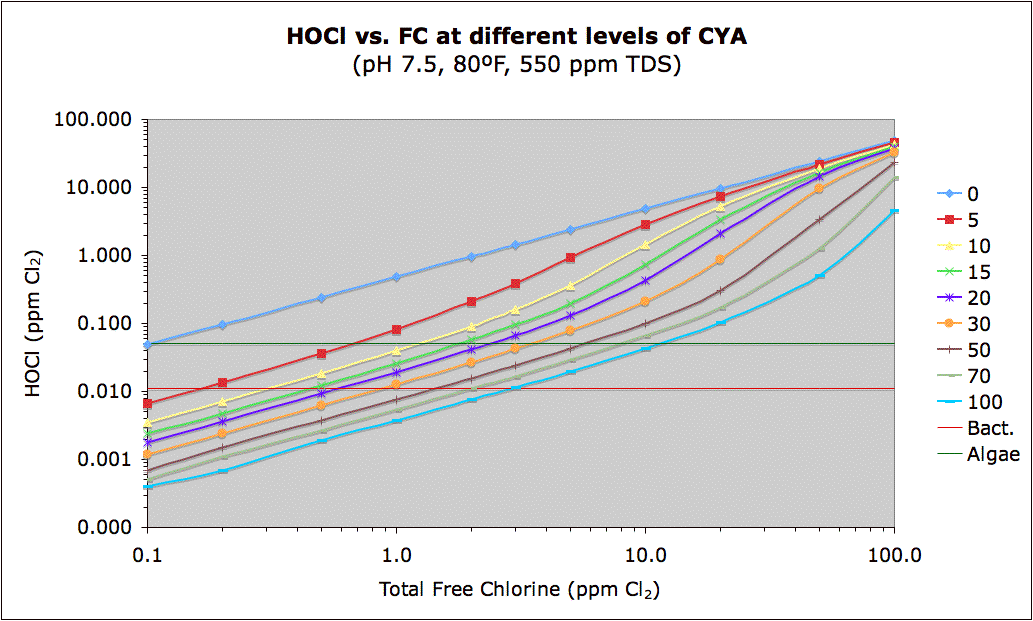New to our home and did OK last summer but taking the chemistry into our own hands this year. I understand the relationship between CYA and FC - but everywhere tells your “1-3” ppm for chlorine. I get that if my CYA is 60 - F. Should be more like 5-6ppm. And, if my CYA is 100, that’s high and my FC should be 9-10. BUT - what I’m trying to understand is - is it safe to swim with a FC of 9-10ppm? Everywhere (aka pool store and google cough cough) says that would cause irritation. So would my goal then Be to work to lower my CYA via draining and filling while dealing with my chlorine inadequately dunctioning because of my high cya?
CYA:FC relationship but 10ppm chlorine unsafe for swimming?
- Thread starter MontereyofSunshine
- Start date
You are using an out of date browser. It may not display this or other websites correctly.
You should upgrade or use an alternative browser.
You should upgrade or use an alternative browser.
- Aug 20, 2020
- 5,729
- Pool Size
- 27000
- Surface
- Plaster
- Chlorine
- Salt Water Generator
- SWG Type
- CircuPool RJ-60
If sage to swim up to SLAM level. I’ve personally swam in our pool during a SLAM when the FC level was 15ppm-ish. I didn’t notice any difference.New to our home and did OK last summer but taking the chemistry into our own hands this year. I understand the relationship between CYA and FC - but everywhere tells your “1-3” ppm for chlorine. I get that if my CYA is 60 - F. Should be more like 5-6ppm. And, if my CYA is 100, that’s high and my FC should be 9-10. BUT - what I’m trying to understand is - is it safe to swim with a FC of 9-10ppm? Everywhere (aka pool store and google cough cough) says that would cause irritation. So would my goal then Be to work to lower my CYA via draining and filling while dealing with my chlorine inadequately dunctioning because of my high cya?
The issue is that the CYA holds onto a percentage of the chlorine in the water in a kind of “reserve” where isn’t not doing anything. But the chlorine test can’t tell the difference and so it shows all the chlorine whether it’s bound to CYA or not.
The articles telling you to keep it between 1-3ppm also state the CYA needs to be below 30ppm (or some other small number) that was coined decades ago and never updated.
At some point a high CYA causes you to need more than 10ppm of chlorine which makes some of the other tests complicated. That’s why TFP recommends keeping it under 80ppm when using a salt chlorinator or 60ppm for liquid chlorine. If you can manage the water with 30ppm CYA, that’s also ok. There’s not requirement to have the high CYA just that TFP has found you can get away with it often.
Sunshine,
As long as you keep your CYA and FC in the proper relationship, then you can swim in a pool right up to the SLAM level.
It is perfectly safe and less active chlorine than you will find in most public pools.
FC/CYA Levels
That said, it makes sense in the long run to get your CYA in the normal range when you can.
Thanks,
Jim R.
As long as you keep your CYA and FC in the proper relationship, then you can swim in a pool right up to the SLAM level.
It is perfectly safe and less active chlorine than you will find in most public pools.
FC/CYA Levels
That said, it makes sense in the long run to get your CYA in the normal range when you can.
Thanks,
Jim R.
- Jun 24, 2021
- 7,504
- Pool Size
- 30000
- Surface
- Vinyl
- Chlorine
- Salt Water Generator
- SWG Type
- CircuPool RJ-60
The thing is that it is HOCl (Hypochlorous acid) is what is in the water that sanitizes. This is the "active" chlorine, the stuff that is harsh on skin and suits.I get that if my CYA is 60 - F. Should be more like 5-6ppm. And, if my CYA is 100, that’s high and my FC should be 9-10. BUT - what I’m trying to understand is - is it safe to swim with a FC of 9-10ppm? Everywhere (aka pool store and google cough cough) says that would cause irritation.
Look at the 6th dot on the upper Blue line. That is 3ppm Free Chlorine at 0 CYA, it has just over 1ppm HOCl.
Note the Brown line, look at the 8th hash. That is 10ppm FC at 50 CYA, it has about .1ppm HOCl.
So, with CYA of 50 and FC of 10, the HOCl concentration is about 1/10 that of 3ppm and 0 CYA.
That is why it is safe...

poolnovice1
Bronze Supporter
4ppm is the maximum allowed in drinking water. And that is at 0 CYA. I'm more worried about chlorine in my drinking water than I am about chlorine levels in my pool at the appropriate FC/CYA levels.
CYA ~50-60 is the sweet spot for me.
CYA ~50-60 is the sweet spot for me.
Thread Status
Hello , This thread has been inactive for over 60 days. New postings here are unlikely to be seen or responded to by other members. For better visibility, consider Starting A New Thread.

